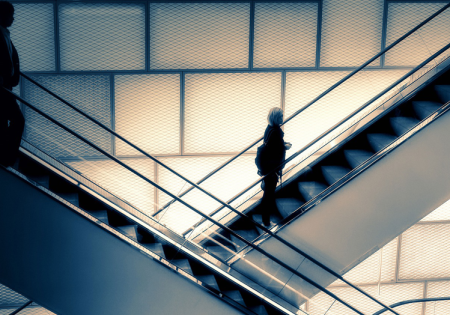Manish Mehan (MM), CEO, thyssenkrupp Elevator (India), shares insights with your author (SSP).
SSP: How would you describe the scope for modernization of existing elevators and escalators in the current scenario?
MM: The growth of the elevator and escalator modernization market is highly influenced by the increasing need for a smooth and efficient mobility system inside buildings, owing to increasing urbanization. Moreover, rising concern for safe operation of elevators and escalators is also acting as a growth factor for their modernization. Since the average lifespan of elevators and escalators is 20-30 years, this equipment needs continual maintenance or modernization to function efficiently. Some state lift acts in India specify the useful life of an elevator and define guidelines for their partial or complete modernization.

For example, the Haryana Lifts and Escalators Act specifies the useful life of an elevator as 20 years. Moreover, old elevators and escalators installed in 1995-2005 tend to be less cost-effective, as most of them function with obsolete parts. This is a driving factor for the modernization business: these obsolete parts have to be replaced by new, cost-effective spare parts to achieve optimal configuration and profitable operation. Nowadays, many customers ask for state-of-the-art technology with the latest safety features. That makes modernization necessary. Sometimes, however, the entire unit must be replaced. This further boosts the growth of the elevator and escalator modernization market.
SSP: How are advances in technology enabling elevators and escalators to become future-ready?
MM: Today’s elevators and escalators are equipped with advanced technology, including power-saving and safety features to offer greater efficiency and comfort, better reliability, increased product life, low operating costs and enhanced safety. Energy-efficient control systems are being developed to cater to the expectation of carbon footprint reduction.
As a company, thyssenkrupp Elevator always aims to be on the forefront of providing innovative mobility solutions and focuses on providing such solutions that are tailored for rapidly developing urban areas. The company invests significant resources in R&D with a goal that its products achieve higher efficiency, lower maintenance and minimal emissions. The company has introduced the following technologies:
- MULTI is the first rope-free elevator that moves multiple cars in a single shaft vertically and horizontally and reduces elevators’ footprint by up to 50%, while increasing passenger throughput. The system is designed so architects and developers are no longer restricted in their designs by concerns about elevator shaft height and vertical alignment.
- The TWIN elevator system has two cabs running independently in the same shaft, each with its own counterweight, safety and drive equipment. It comes equipped with intelligent traffic control, which optimizes traffic automatically and reduces empty runs. It is designed to use less energy yet transport up to 40% more passengers than conventional elevators.
- MAX is a predictive, preemptive service solution that extends remote-monitoring capabilities to increase current availability levels for both existing and new elevators. Utilizing Microsoft Azure Internet of Things technology, MAX makes it possible for an elevator to “tell” service technicians its real needs, including real-time identification of repairs, component replacements and proactive system maintenance.
- ACCEL is a moving walk designed to offer high capacities and high speeds for short distances with no waiting times. Passengers step onto it at normal walking speeds, accelerate smoothly up to 7.2 km/h (12 km/h for passengers who continue walking), then decelerate to normal speed when disembarking.
- SSP: Which are the specific aspects being considered in the modernization of elevators and escalators, especially in the COVID-19 pandemic?
MM: Modernization provides the opportunity for improved safety, better performance, improved energy efficiency, increased property value, a more comfortable ride and an overall more pleasing experience. During such crises, the first and foremost aspect to consider is elevator modernization, while implementing all COVID-19-related safety measures, including mandatory usage of personal protective equipment by elevator teams onsite and proper sanitization of equipment and the site to avoid spread of coronavirus. Our modernization teams have safely and successfully completed many modernization projects across the country during the lockdown period.
SSP: To what extent is there scope for modernizing elevator lobbies in synchronization with elevators to reduce the pressure on vertical transportation (VT)?
MM: Scope for modernizing the elevator lobby usually lies with the developer or building society. It’s usually effected during building redevelopment. The societies usually do not go for large-scale lobby modernization due to higher costs; they try to manage with minor repairs and repainting as needed. Having said that, most buildings are designed in a way that additional lifts cannot be installed. However, modernization provides opportunities for bigger cabins, higher speed or TWIN installation to increase the capacity and/or reduce travel time.
SSP: Is there a market for elevators from the real estate redevelopment/refurbishment segment?
MM: In the wake of the stagnating real estate market, approval delays, stringent norms and reduced margins, redevelopment projects in India have been losing their charm among developers and evinced a sharp decline in 2019-2020. In the current situation, this segment does not appear to be as lucrative for the elevator industry as had been anticipated. However, government-promoted public infrastructure redevelopment projects, such as for metros and airports, hold promise for increased VT business.
Get more of Elevator World. Sign up for our free e-newsletter.









